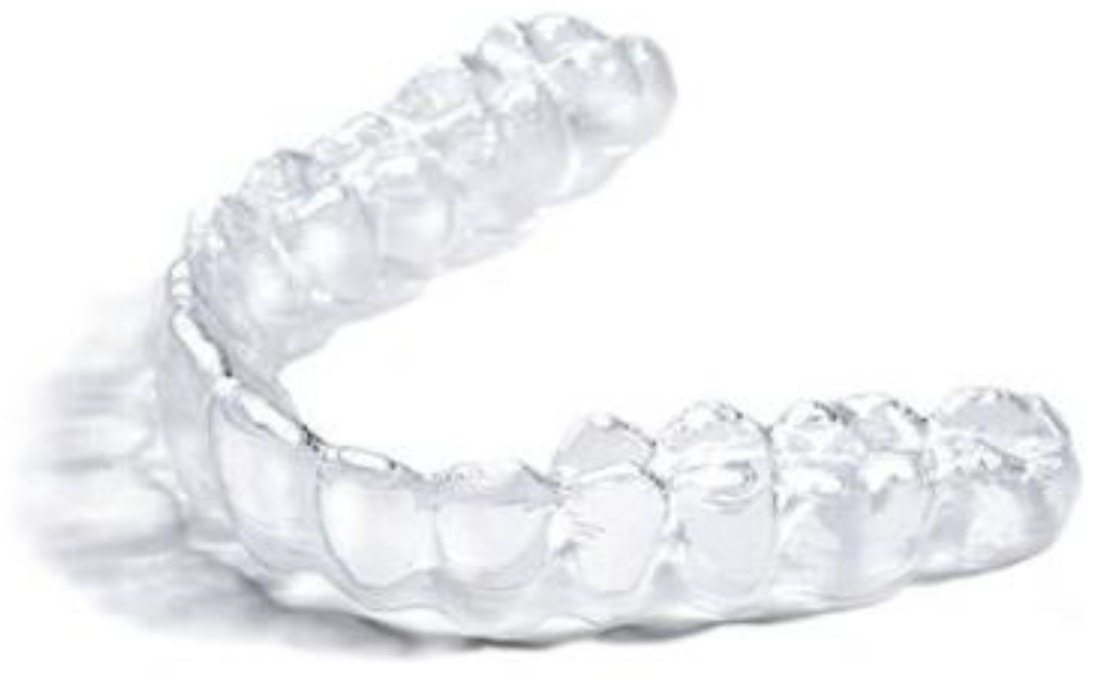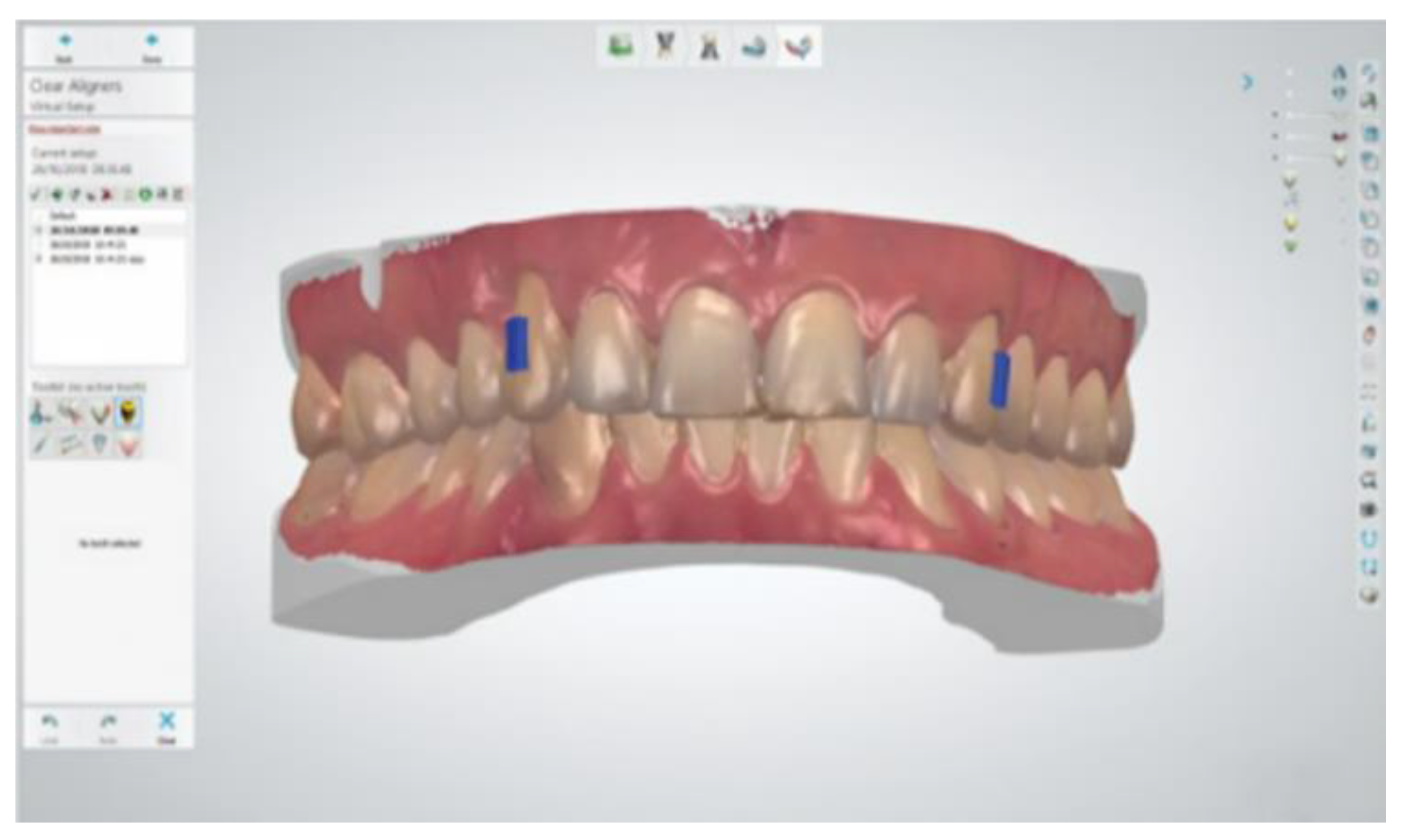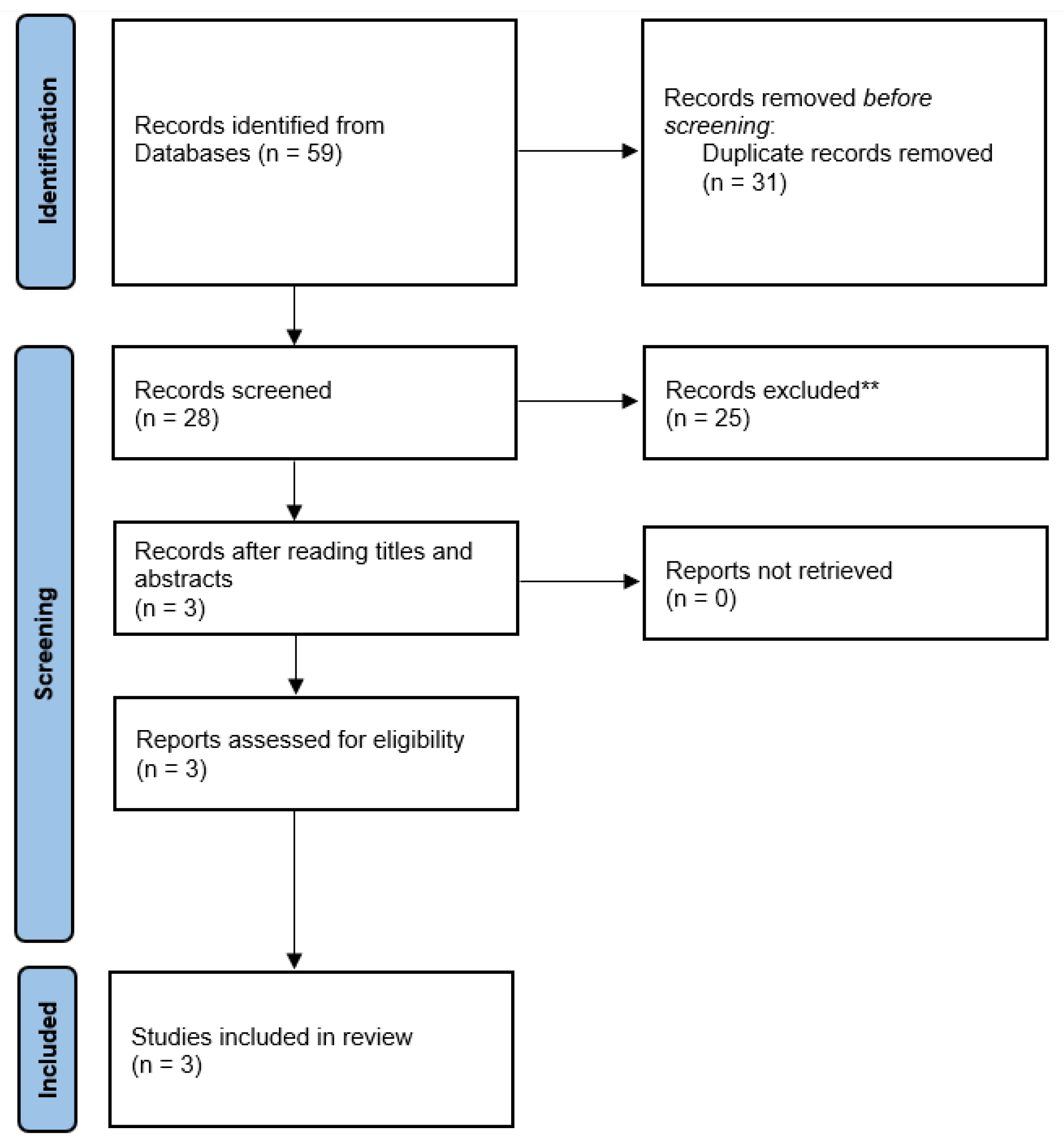The Effectiveness of Dental Bleaching during Orthodontic Treatment with Clear Aligners: A Systematic Review
Abstract
1. Introduction
2. Materials and Methods
2.1. Protocol
2.2. Search Strategy
2.3. Inclusion Criteria
2.4. Exclusion Criteria
2.5. Study Selection
2.6. Data Extraction
2.7. Assessment of Methodological Quality
| Author & Year | Study Design | Sample Size and Tooth Shade at Baseline | Bleaching Agents and Groups | Type of Clear Aligner Used | Evaluation Criteria | Follow-Up Period | Treatment Outcome |
|---|---|---|---|---|---|---|---|
| Oliverio et al., 2019 [37] | Clinical study | 38 patients | Group 1: 3% hydrogen peroxide, 9 h, on days 7–14 of aligner wear Group 2: 10% carbamide peroxide, 9 h, on days 7–14 of aligner wear Group 3: 16% carbamide peroxide, 9 h, on days 7–14 of aligner wear Group 4: 16% carbamide peroxide, 9 h, on days 1–14 of aligner wear | F22 aligners | Spectrophotometer and Vita Classical shade guide, three readings for each tooth of the six maxillary anterior teeth (incisal, middle, and cervical) | Re-evaluation was done at day 14 of aligner use; however, patients in groups 1–3 only received bleaching for one week compared to patients in group 4 who received two weeks of bleaching | Group 4 showed the greatest shade improvement; only patients in group 1 showed sites which had worsening in tooth shade |
| Levrini et al., 2020 [35] | Clinical study | 10 patients | 10% carbamide peroxide, 8 hrs, for 10 days; control teeth 41 and 32 received bleaching using bleaching trays while study teeth 31 and 42 received bleaching using Invisalign aligners | Invisalign | Spectrophotometer | Ten days | Both types of trays (bleaching trays, Invisalign aligners) were effective in bleaching without any significant differences between the types |
| Seleem et al., 2021 [36] | Clinical study | 28 patients Baseline shade: 6.1 | 10% carbamide peroxide, two groups; control group where patients did not receive bleaching, study group where patients received bleaching using 10% carbamide peroxide for 8 hrs for 4 weeks | Invisalign | Vita Classical shade guide, middle third of maxillary and mandibular central and lateral incisors | At 2 and 4 weeks of dental bleaching and 2 weeks after bleaching termination (weeks 2, 4, and 6) | About half of the patients in the study group had a 3–6-shade improvement, while the remaining subjects showed an improvement of about 1–2 shades or more than 7 shades. Patients in the control group had a consistent shade average throughout the duration of the study |
3. Results
4. Discussion
5. Conclusions
Author Contributions
Funding
Institutional Review Board Statement
Informed Consent Statement
Data Availability Statement
Conflicts of Interest
References
- Vlaskalic, V.; Boyd, R. Orthodontic treatment of a mildly crowded malocclusion using the Invisalign System. Aust. Orthod. J. 2001, 17, 41–46. [Google Scholar] [PubMed]
- Wheeler, T.T. Orthodontic clear aligner treatment. Semin. Orthod. 2017, 23, 83–89. [Google Scholar] [CrossRef]
- Weir, T. Clear aligners in orthodontic treatment. Aust. Dent. J. 2017, 62 (Suppl. S1), 58–62. [Google Scholar] [CrossRef] [PubMed]
- Rossini, G.; Parrini, S.; Castroflorio, T.; Deregibus, A.; Debernardi, C.L. Efficacy of clear aligners in controlling orthodontic tooth movement: A systematic review. Angle Orthod. 2015, 85, 881–889. [Google Scholar] [CrossRef] [PubMed]
- Putrino, A.; Barbato, E.; Galluccio, G. Clear Aligners: Between evolution and efficiency-A scoping review. Int. J. Environ. Res. Public Health 2021, 18, 2870. [Google Scholar] [CrossRef]
- Tartaglia, G.M.; Mapelli, A.; Maspero, C.; Santaniello, T.; Serafin, M.; Farronato, M.; Caprioglio, A. Direct 3D printing of clear orthodontic aligners: Current state and future possibilities. Materials 2021, 14, 1799. [Google Scholar] [CrossRef]
- Hennessy, J.; Al-Awadhi, E.A. Clear aligners generations and orthodontic tooth movement. J. Orthod. 2016, 43, 68–76. [Google Scholar] [CrossRef]
- Bräscher, A.K.; Zuran, D.; Feldmann REJr Benrath, J. Patient survey on Invisalign® treatment comparing [corrected] the SmartTrack® material to the previously used [corrected] aligner material. J. Orofac. Orthop. 2016, 77, 432–438. [Google Scholar] [CrossRef]
- Lagravère, M.O.; Flores-Mir, C. The treatment effects of Invisalign orthodontic aligners: A systematic review. J. Am. Dent. Assoc. 2005, 136, 1724–1729. [Google Scholar] [CrossRef]
- Phan, X.; Ling, P.H. Clinical limitations of Invisalign. J. Can. Dent. Assoc. 2007, 73, 263–266. [Google Scholar]
- Pogal-Sussman-Gandia, C.B.; Tabbaa, S.; Al-Jewair, T. Effects of Invisalign® treatment on speech articulation. Int. Orthod. 2019, 17, 513–518. [Google Scholar] [CrossRef] [PubMed]
- Alajmi, S.; Shaban, A.; Al-Azemi, R. Comparison of short-term oral impacts xperienced by patients treated with Invisalign or conventional fixed orthodontic appliances. Med. Princ. Pract. 2020, 29, 382–388. [Google Scholar] [CrossRef] [PubMed]
- Borda, A.F.; Garfinkle, J.S.; Covell, D.A.; Wang, M.; Doyle, L.; Sedgley, C.M. Outcome assessment of orthodontic clear aligner vs fixed appliance treatment in a teenage population with mild malocclusions. Angle Orthodtist 2020, 90, 485–490. [Google Scholar] [CrossRef] [PubMed]
- Lanteri, V.; Farronato, G.; Lanteri, C.; Caravita, R.; Cossellu, G. The efficacy of orthodontic treatments for anterior crowding with Invisalign compared with fixed appliances using the Peer Assessment Rating Index. Quintessence Int. 2018, 49, 581–587. [Google Scholar] [PubMed]
- Bonnick, A.M.; Nalbandian, M.; Siewe, M.S. Technological advances in nontraditional orthodontics. Dent. Clin. N. Am. 2011, 55, 571–584. [Google Scholar] [CrossRef]
- Kuncio, D.A. Invisalign: Current guidelines for effective treatment. N. Y. State Dent. J. 2014, 80, 11–14. [Google Scholar]
- Vijay Rudrappa, N.; Pooja, C. Invisalign: The invisible braces. Int. J. Contemp. Dent. 2010, 1, 54–57. [Google Scholar]
- Sword, R.J.; Haywood, V.B. Teeth bleaching efficacy during clear aligner orthodontic treatment. Compend. Contin. Educ. Dent. 2020, 41, e6–e11. [Google Scholar]
- Davis, L.G.; Ashworth, P.D.; Spriggs, L.S. Psychological effects of aesthetic dental treatment. J. Dent. 1998, 26, 547–554. [Google Scholar] [CrossRef]
- Hintz, J.K.; Bradley, T.G.; Eliades, T. Enamel colour changes following whitening with 10 per cent carbamide peroxide: A comparison of orthodontically-bonded/debonded and untreated teeth. Eur. J. Orthod. 2001, 23, 411–415. [Google Scholar] [CrossRef]
- Krug, A.Y.; Green, C. Changes in patient evaluation of completed orthodontic esthetics after dental bleaching. J. Esthet. Restor. Dent. 2008, 20, 313–319, discussion 320–321. [Google Scholar] [CrossRef] [PubMed]
- Haywood, V.B.; Heymann, H.O. Nightguard vital bleaching. Quintessence Int. 1989, 20, 173–176. [Google Scholar] [PubMed]
- Fasanaro, T.S. Bleaching teeth: History, chemicals, and methods used for common tooth discolorations. J. Esthet. Dent. 1992, 4, 71–78. [Google Scholar] [CrossRef] [PubMed]
- Haywood, V.B. History, safety, and effectiveness of current bleaching techniques and applications of the nightguard vital bleaching technique. Quintessence Int. 1992, 23, 471–488. [Google Scholar]
- Maran, B.M.; Vochikovski, L.; de Andrade Hortkoff, D.R.; Stanislawczuk, R.; Loguercio, A.D.; Reis, A. Tooth sensitivity with a desensitizing-containing at-home bleaching gel-a randomized triple-blind clinical trial. J. Dent. 2018, 72, 64–70. [Google Scholar] [CrossRef]
- Mounika, A.; Mandava, J.; Roopesh, B.; Karri, G. Clinical evaluation of color change and tooth sensitivity with in-office and home bleaching treatments. Indian J. Dent. Res. 2018, 29, 423–427. [Google Scholar] [CrossRef]
- Chemin, K.; Rezende, M.; Milan, F.M.; Dantas, T.B.; Gomes, K.D.N.; Kossatz, S. Clinical evaluation of 10% hydrogen peroxide on tooth sensitivity and effectiveness in at home dental bleaching. J. Contemp. Dent. Pract. 2018, 19, 1376–1380. [Google Scholar] [CrossRef]
- Alqahtani, M.Q. Tooth-bleaching procedures and their controversial effects: A literature review. Saudi Dent. J. 2014, 26, 33–46. [Google Scholar] [CrossRef]
- Consolaro, A.; Consolaro, R.B.; Francischone, L. Clarifications, guidelines and questions about the dental bleaching” associated” with orthodontic treatment. Dent. Press J. Orthod. 2013, 18, 4–10. [Google Scholar] [CrossRef]
- Lazarchik, D.A.; Van Haywood, B. Use of tray-applied 10 percent carbamide peroxide gels for improving oral health in patients with special-care needs. J. Am. Dent. Assoc. 2010, 141, 639–646. [Google Scholar] [CrossRef]
- Haywood, V.B.; Leonard, R.H.; Jr Nelson, C.F. Efficacy of foam liner in 10% carbamide peroxide bleaching technique. Quintessence Int. 1993, 24, 663–666. [Google Scholar] [PubMed]
- Javaheri, D.S.; Janis, J.N. The efficacy of reservoirs in bleaching trays. Oper. Dent. 2000, 25, 149–151. [Google Scholar]
- Miller, M.B.; Castellanos, I.R.; Rieger, M.S. Efficacy of home bleaching systems with and without tray reservoirs. Pract. Periodontics Aesthetic Dent. PPAD 2000, 12, 611–614. [Google Scholar]
- Haywood, V. The bottom line on bleaching 2008. Inside Dent. 2008, 4, 82–89. [Google Scholar]
- Levrini, L.; Paracchini, L.; Bakaj, R.; Diaconu, A.; Cortese, S. Dental bleaching during orthodontic treatment with aligners. Int. J. Esthet. Dent. 2020, 15, 44–54. [Google Scholar] [PubMed]
- Seleem, D.; Dadjoo, S.; Ha, A.; Santos, C.; Mirfarsi, S.; Matsumura-Lem, K.; Lazarchik, D. Effect of 10% carbamide peroxide on tooth shade, plaque index and gingival index during invisalign treatment. Dent. J. 2021, 9, 48. [Google Scholar] [CrossRef] [PubMed]
- Oliverio, T.; Cremonini, F.; Lombardo, L.; Siciliani, G. Tooth whitening in association with clear aligner treatment. J. Clin. Orthod. 2019, 53, 508–517. [Google Scholar]
- Martini, E.C.; Parreiras, S.O.; Acuña, E.D.; Loguercio, A.D.; Reis, A. Does the use of reservoirs have any impact on the efficacy of at-home bleaching? A systematic review. Braz. Dent. J. 2019, 30, 285–294. [Google Scholar] [CrossRef]
- Martini, E.C.; Favoreto, M.W.; Coppla, F.M.; Loguercio, A.D.; Reis, A. Evaluation of reservoirs in bleaching trays for at-home bleaching: A split-mouth single-blind randomized controlled equivalence trial. J. Appl. Oral Sci. 2020, 28, e20200332. [Google Scholar] [CrossRef]
- Martini, E.C.; Favoreto, M.W.; de Andrade, H.F.; Coppla, F.M.; Loguercio, A.D.; Reis, A. One-year follow-up evaluation of reservoirs in bleaching trays for at-home bleaching. J. Esthet. Restor. Dent. 2021, 33, 992–998. [Google Scholar] [CrossRef]
- Al-Angari, S.S.; Lippert, F.; Platt, J.A.; Eckert, G.J.; González-Cabezas, C.; Li, Y.; Hara, A.T. Dental bleaching efficacy and impact on demineralization susceptibility of simulated stained-remineralized caries lesions. J. Dent. 2019, 81, 59–63. [Google Scholar] [CrossRef] [PubMed]
- Cavalli, V.; Rosa, D.A.D.; Silva, D.P.D.; Kury, M.; Liporoni, P.C.S.; Soares, L.E.S.; Martins, A.A. Effects of experimental bleaching agents on the mineral content of sound and demineralized enamels. J. Appl. Oral Sci. 2018, 26, e20170589. [Google Scholar] [CrossRef] [PubMed]
- Salomão, D.; Santos, D.; Nogueira, R.; Palma-Dibb, R.; Geraldo-Martins, V. Acid demineralization susceptibility of dental enamel submitted to different bleaching techniques and fluoridation regimens. Oper. Dent. 2014, 39, E178–E185. [Google Scholar] [CrossRef] [PubMed]
- Zanolla, J.; Marques, A.; da Costa, D.C.; de Souza, A.S.; Coutinho, M. Influence of tooth bleaching on dental enamel microhardness: A systematic review and meta-analysis. Aust. Dent. J. 2017, 62, 276–282. [Google Scholar] [CrossRef] [PubMed]
- Kamath, U.; Sheth, H.; Mullur, D.; Soubhagya, M. The effect of Remin Pro® on bleached enamel hardness: An in-vitro study. Indian J. Dent. Res. 2013, 24, 690–693. [Google Scholar]
- Borges, A.B.; Yui, K.C.; D’Avila, T.C.; Takahashi, C.L.; Torres, C.R.; Borges, A.L. Influence of remineralizing gels on bleached enamel microhardness in different time intervals. Oper. Dent. 2010, 35, 180–186. [Google Scholar] [CrossRef]
- Kaur, G.; Sanap, A.U.; Aggarwal, S.D.; Kumar, T. Comparative evaluation of two different remineralizing agents on the microhardness of bleached enamel surface: Results of an in vitro study. Indian J. Dent. Res. 2015, 26, 176–179. [Google Scholar] [CrossRef]




| Oliverio et al., 2019 [37] | Levrini et al., 2020 [35] | Seleem et al., 2021 [36] | |
|---|---|---|---|
| Random sequence generation (selection bias) |  |  |  |
| Allocation concealment (selection bias) |  |  |  |
| Blinding of participants and personnel (performance bias) |  |  |  |
| Blinding of outcome assessment (detection bias) |  |  |  |
| Incomplete outcome data (attrition bias) |  |  |  |
| Selective reporting (reporting bias) |  |  |  |
| Other bias |
 Low Risk
Low Risk  Some concerns
Some concerns  High Risk.
High Risk.Publisher’s Note: MDPI stays neutral with regard to jurisdictional claims in published maps and institutional affiliations. |
© 2022 by the authors. Licensee MDPI, Basel, Switzerland. This article is an open access article distributed under the terms and conditions of the Creative Commons Attribution (CC BY) license (https://creativecommons.org/licenses/by/4.0/).
Share and Cite
Khashashneh, M.; Ratnayake, J.; Choi, J.J.E.; Mei, L.; Lyons, K.; Brunton, P.A. The Effectiveness of Dental Bleaching during Orthodontic Treatment with Clear Aligners: A Systematic Review. Appl. Sci. 2022, 12, 11274. https://doi.org/10.3390/app122111274
Khashashneh M, Ratnayake J, Choi JJE, Mei L, Lyons K, Brunton PA. The Effectiveness of Dental Bleaching during Orthodontic Treatment with Clear Aligners: A Systematic Review. Applied Sciences. 2022; 12(21):11274. https://doi.org/10.3390/app122111274
Chicago/Turabian StyleKhashashneh, Majd, Jithendra Ratnayake, Joanne Jung Eun Choi, Li Mei, Karl Lyons, and Paul A. Brunton. 2022. "The Effectiveness of Dental Bleaching during Orthodontic Treatment with Clear Aligners: A Systematic Review" Applied Sciences 12, no. 21: 11274. https://doi.org/10.3390/app122111274
APA StyleKhashashneh, M., Ratnayake, J., Choi, J. J. E., Mei, L., Lyons, K., & Brunton, P. A. (2022). The Effectiveness of Dental Bleaching during Orthodontic Treatment with Clear Aligners: A Systematic Review. Applied Sciences, 12(21), 11274. https://doi.org/10.3390/app122111274







